Comparing and ordering fractions in 3rd Grade: Worksheets, tips, and tricks
Hi there! Welcome to this fun, enriching article about comparing and ordering fractions in 3rd Grade. This article will share some fraction worksheets, tips, and tricks to help you master this important math skill. Fractions are not only fun to learn, but they are also useful in everyday life.
Let's get started!
-
Why fractions are important and fun to learn
Apart from simply being a math concept in Grade 3, fractions are also important and fun to learn. But before discovering why they are important, let’s first understand what they mean!
Fractions are a way of representing parts of a whole. For example, if you have a pizza and you cut it into four equal slices, each slice is one-fourth of the pizza. You can write this fraction as 1/4. Fractions can also represent parts of a set. For example, if you have 12 candies and eat 3 of them, you have eaten one-fourth. You can write this fraction as 3/12.
Fractions are important because they help us measure, compare, and divide things. For example, if you want to bake a cake and need half a cup of sugar, you can use a fraction to measure the amount of sugar. If you want to compare the sizes of two pizzas, you can use fractions to see which one is bigger or smaller. If you want to share a chocolate bar with your friend, you can use fractions to divide it equally.
Fractions are also fun to learn because they allow us to explore different patterns, shapes, and numbers. Mathskills4kids.com has designed many examples and fun uses of fractions in math and our daily activities. First, you can use fractions to create colorful art with paper or tiles. You can use fractions to discover how numbers are related to each other. You can use fractions to play games and puzzles with your friends.
-
BROWSE THE WEBSITE
-
DOWNLOAD FREE WORKSHEETS
-
-
3rd GRADE MATH TOPICS
- Number and compapring
- Place value
- Addition
- Subtraction
- Understand multiplication
- Multiplication skill builders
- Multiplication fluency
- Multiplication
- Understand division
- Division skill builders
- Division fluency
- Division practice
- Mixed operation
- Properties
- Equations & variations
- Estimate & rounding
- Logical reasoning
- Patterns
- Money
- Telling time
- Data graph & probability
- Understanding fractions
- Equivalent fractions
- Comparing and ordering fractions
- Operations with fractions
- Unit of measurement
- Two-dimensional shapes
- Triangles and quadrilaterals
- 3D shapes
- Geometric measurement
-
-
How to compare fractions using models with like denominators (1)
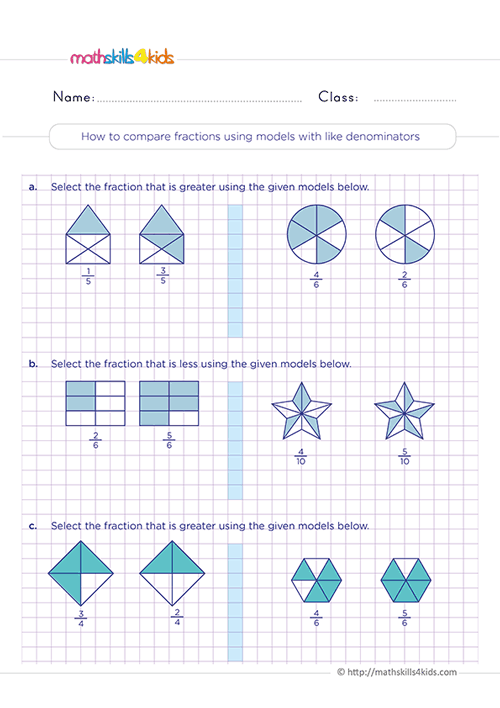 Print it...
Print it...
-
How to compare fractions using models with like denominators (2)
 Print it...
Print it...
-
Comparing fractions using number line
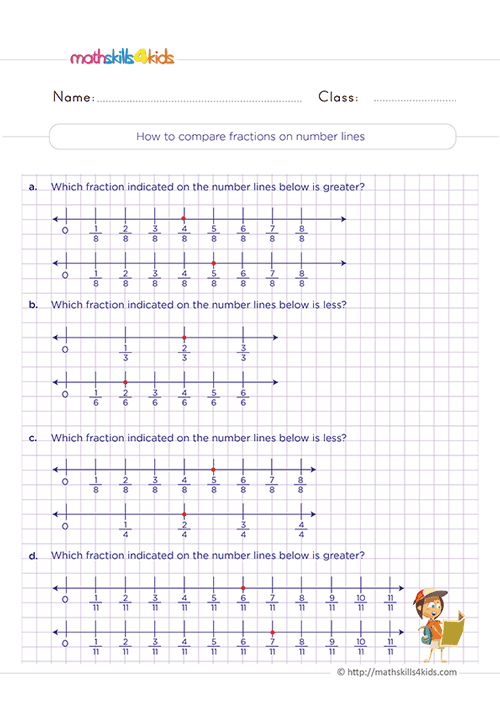 Print it...
Print it...
-
Comparing and ordering fractions
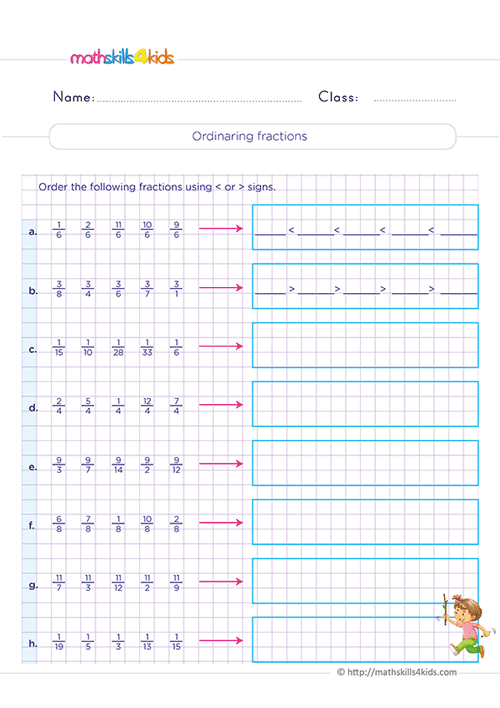 Print it...
Print it...
-
Graph and compare fractions using number lines
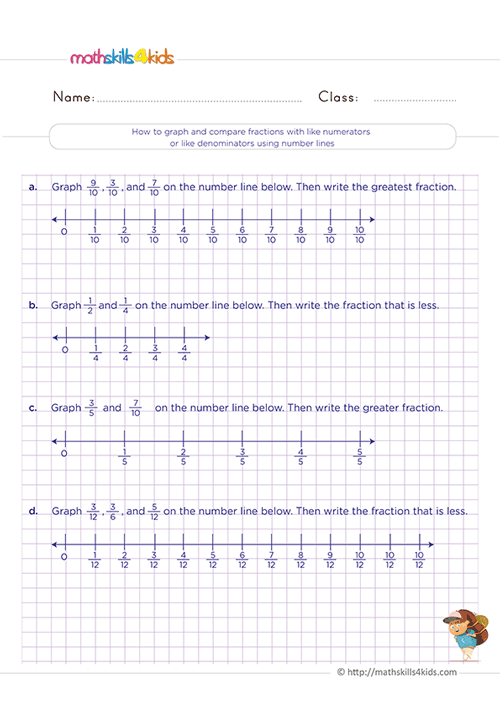 Print it...
Print it...
-
Comparing fractions in recipes practice
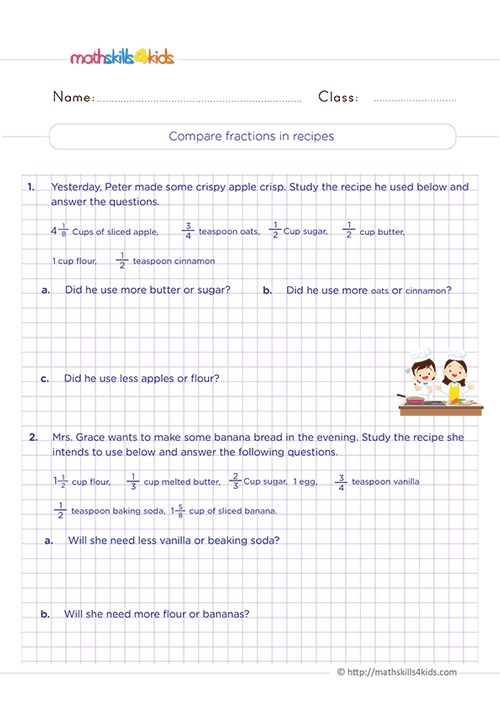 Print it...
Print it...
-
How to compare fractions using models with like denominators (1)
-
Buying is supporting us!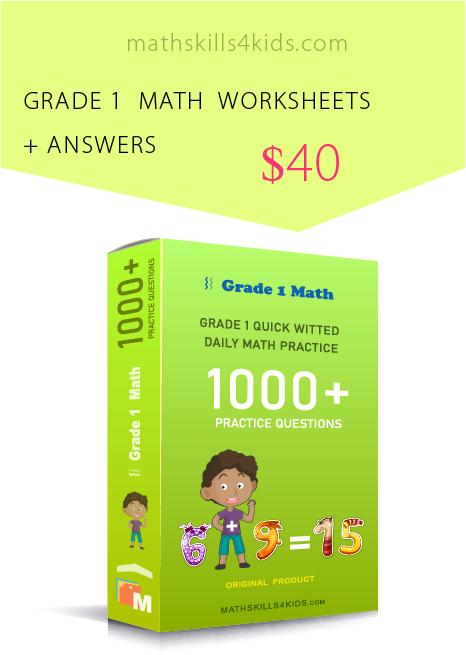
Buy Now...
-
-
Review: What are fractions, and how to write them
Now that we know how important fractions are in math and our daily lives let’s learn what they are and how to write them.
A fraction is a number that shows how many parts of a whole or a set are being considered. A fraction has two parts: a numerator and a denominator. The numerator is the number above the fraction bar, which tells how many parts are being considered. The denominator is the number below the fraction bar, which tells how many equal parts the whole or the set is divided into.
For example, in the fraction 2/5, the numerator is 2, and the denominator is 5. This means that we are considering 2 parts out of 5 equal parts.
To write a fraction, we need to follow these steps:
- Identify the whole or the set that we are working with.
- Divide the whole or the set into equal parts.
- Count how many parts we are considering.
- Write the fraction using the numerator and the denominator.
For example, if we have a circle and we divide it into four equal parts, we can write fractions to represent each part or combination of parts.
- One part is 1/4 of the circle.
- Two parts are 2/4 of the circle.
- Three parts are 3/4 of the circle.
- Four parts are 4/4 of the circle.
-
Some examples of engaging and challenging worksheets, tips, and tricks to practice comparing and ordering fractions in 3rd grade
Are you already a master of comparing and ordering fractions? Uplift your skills with examples of engaging and challenging practice worksheets using different tips and tricks.
Let’s get started:
- How to compare fractions using models with like denominators: In this worksheet, you will see different fraction models with the same denominator. You need to compare the fractions using the greater than (>), less than (<), or equal to (=) signs.
- How to compare fractions using models with unlike denominators: In this worksheet, you will see different fraction models with different denominators. You need to compare the fractions using the greater than (>), less than (<), or equal to (=) signs. You may need to use equivalent fractions to help you compare them. For example, https://mathskills4kids.com/comparing-and-ordering-fractions-3rd-grade.
- Compare fractions in recipes: In this worksheet, you will see different recipes that use fractions to measure ingredients. You need to compare the fractions in each recipe and see which uses more or less of a certain ingredient.
- Comparing fractions using benchmarks: In this worksheet, you will see different fractions to compare using benchmarks. Benchmarks are common fractions you can use as reference points, such as 1/2, 1/4, 3/4, etc.
- Ordering fractions with the same denominators or numerators: In this worksheet, you will see different fractions with either the same denominator or the same numerator. You need to order them from least to greatest or greatest to least. For example; https://www.mathworksheets4kids.com/ordering-fractions/
-
Tips and tricks: Some helpful hints and shortcuts to make comparing and ordering fractions in Grade 3 easier and faster
Comparing and ordering fractions can be tricky sometimes, but some tips and tricks can make it easier and faster. Here are some of them:
- If two fractions have the same denominator, the one with the larger numerator is larger.
- If two fractions have the same numerator, the one with the smaller denominator is larger.
- If two fractions have different denominators, you can cross-multiply them and compare the products.
Then, you can compare 10 and 9 and see that 10 is larger than 9. So, 2/3 is larger than 3/5.
- You can also use common factors to simplify fractions before comparing or ordering them. For example, to compare 8/12 and 8/16, you can simplify them by dividing the numerator and denominator by their common factor of 6. Then, you get 2/3 and 2/4. Now, it's easier to see that 2/3 is larger than 2/4.
- You can also use common multiples to find equivalent fractions before comparing or ordering them. For example, to compare 2/5 and 3/8, you can find a common multiple of their denominators, which is 40. Then, you can multiply the numerator and denominator by the same factor to get equivalent fractions with 40 as the denominator. Then, you get 16/40 and 15/40. Now, it's easier to see that 16/40 is larger than 15/40.
-
Real-world applications of comparing and ordering fractions
You might wonder why you must learn to compare and order fractions. After all, when will you ever use fractions in real life? The answer is: more often than you think! Using Mathskills4kids’ fractions worksheets designed with real-life examples, you will realize that fractions are everywhere, and comparing and ordering them can help you make sense of the world around you.
Here are some examples of real-world applications of comparing and ordering fractions:
- Cooking and baking: When you follow a recipe, you need to measure ingredients using fractions. For example, you might need 1/4 cup of sugar, 3/4 teaspoon of salt, or 2/3 cup of milk. Sometimes, you might need to adjust the recipe to make more or less servings. In that case, you need to compare and order fractions to see how much each ingredient you need.
For example, if you want to double a recipe for 1/2 cup of flour, you will use 1 cup of flour. If you want to halve a recipe for 3/4 cup of butter, you will use 3/8 cup of butter.
- Shopping and Budgeting: When you go shopping, you might encounter fractions in prices, discounts, or sales tax. For example, if a shirt is marked down 25%, you will pay 75% of the original price. If the original price was $20, you can compare and order fractions to determine how much you save and pay. You save 25% of $20, which is 1/4 of $20 and $5. You pay 75% of $20, which is 3/4 of $20, which is $15.
- Sports and games: When you play sports or games, you might use fractions to keep score, calculate probabilities, or compare performances. For example, if you play basketball, you might want to know your free throw percentage. That means how many free throws you make out of how many you attempt. If you make 7 free throws out of 10 attempts, your free throw percentage is 7/10 or 70%. You can compare and order fractions to see how your percentage compares to other players or teams.
- Cooking and baking: When you follow a recipe, you need to measure ingredients using fractions. For example, you might need 1/4 cup of sugar, 3/4 teaspoon of salt, or 2/3 cup of milk. Sometimes, you might need to adjust the recipe to make more or less servings. In that case, you need to compare and order fractions to see how much each ingredient you need.
Bonus: Find more resources to reinforce comparing and ordering fractions skills in Third Grade here!
If you are looking for more worksheets, tips, and tricks to practice and reinforce comparing and ordering fractions in 3rd Grade, you are in luck! Many online resources offer engaging and challenging activities for fraction skills. Here are some of the best ones we found:
- Comparing and Ordering Fractions Task Cards: These are 24 colorful cards with fraction problems that require students to compare and order fractions using different strategies. They are perfect for math centers, small groups, or independent practice. You can find them here: https://www.teacherspayteachers.com/Browse/Search:compare%20fractions%20task%20cards
- Digital Activities for Comparing Fractions - Glitter in Third: This website has a bundle of Google Classroom activities that cover comparing fractions with like and unlike denominators and numerators. The activities include short-answer explanations and drag-and-drop questions that require students to use models, number lines, and equivalent fractions. The activities are fun and interactive; you can save 20% if you buy the bundle!
- Free worksheets for comparing or ordering fractions - Homeschool Math: This website has a worksheet generator that lets you create customized worksheets for comparing or ordering fractions.
You can choose the number of problems, the difficulty level, the type of fractions, and whether to include visual models. Also, you can print the worksheets in PDF or HTML format or view them online. The website also has an answer key for each worksheet.
-
Thank you for sharing the links of MathSkills4Kids.com with your loved ones. Your choice is greatly appreciated.
Conclusion: Keep Practicing and Have Fun
We can see that comparing and ordering fractions is an important and fun skill to learn in third grade. It helps students understand the relationship between fractions and how they can use them in real-world situations.
In this article, you learned how to compare and order fractions using models, number lines, equivalent fractions, and benchmarks. You also saw examples of engaging and challenging worksheets to practice these skills. And you discovered some awesome resources to reinforce your children’s learning while having fun with fractions.
We hope you found this article helpful and informative. If you did, please share it with your friends, family, or teachers who might benefit from it. And remember to try out the worksheets and games mentioned above. They will help your 3rd graders master comparing and ordering fractions in no time!
Thank you for reading, and happy learning!
